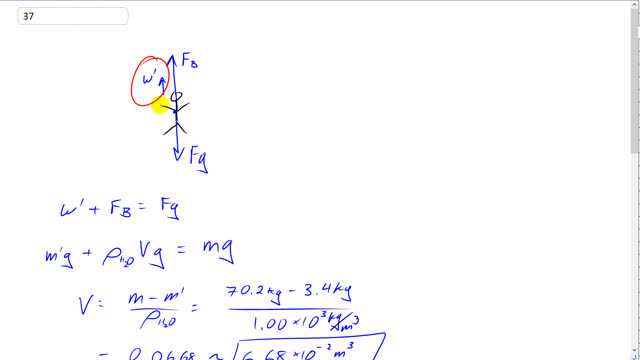
On dry land, an athlete weighs 70.2 kg. The same athlete, when submerged in a swimming pool and hanging from a scale, has an “apparent weight” of 3.4 kg. Using Example 10–8 as a guide,
- find the total volume of the submerged athlete.
- Assume that when submerged, the athlete’s body contains a residual volume of air (mainly in the lungs). Taking to be the actual volume of the athlete’s body, find the body’s specific gravity, SG.
- What is the athlete’s percent body fat assuming it is given by the formula ?

In order to watch this solution you need to have a subscription.
This is Giancoli Answers with Mr. Dychko. When this athlete is submerged, there's going to be two forces upwards on him: there's gonna be the buoyant force due to the water and it's gonna be this apparent weight due to the spring scale that's also pulling him up and those two forces upwards are gonna balance the force of gravity that's downwards. And we can substitute for the apparent weight as being the apparent mass times g and then the buoyant force is gonna be the weight of the water displaced by the athlete which will be the mass of water which is gonna be the density of the water multiplied by the volume of water which is the same as the volume of the athlete since the athlete is totally submerged and times that mass of water by g to get the water's weight and that equals mg—the weight of the athlete— and this m is the true mass measured in a vacuum although measured in air is close enough. So we can rearrange this after canceling the g's and subtracting m prime from both sides and then divide by the density of water on both sides and we get the volume is the true mass minus the apparent mass divided by the density of water. That's 70.2 kilograms minus 3.4 kilograms divided by 1.00 times 10 to the 3 kilograms per cubic meter which gives 6.68 times 10 to the minus 2 cubic meters of volume. The specific gravity of this athlete is density of their body divided by density of water and density of the body is their true mass divided by the volume of their body and the volume of the body we get by taking this number we calculated and then subtracting away the volume of air that's still in their lungs and this gives us just the volume of only their body. So 70.2 divided by this difference divided by the density of water gives 1.07 for the specific gravity. And percent body fat, we take this formula 495 divided by specific gravity 1.0718 and then minus 450 and we get about 12 percent of their body is fat.